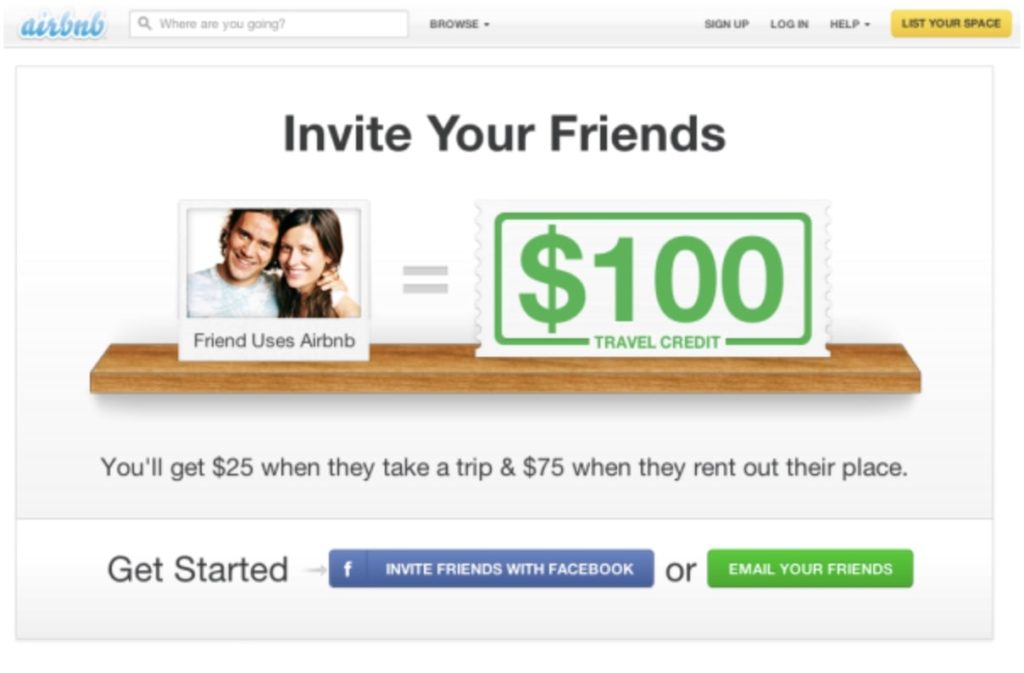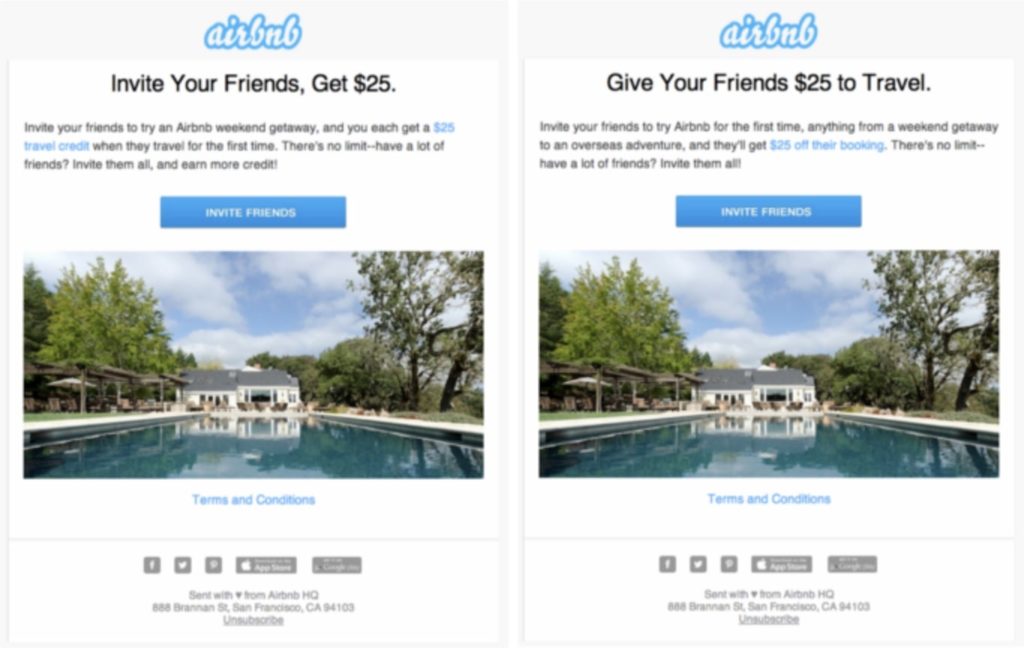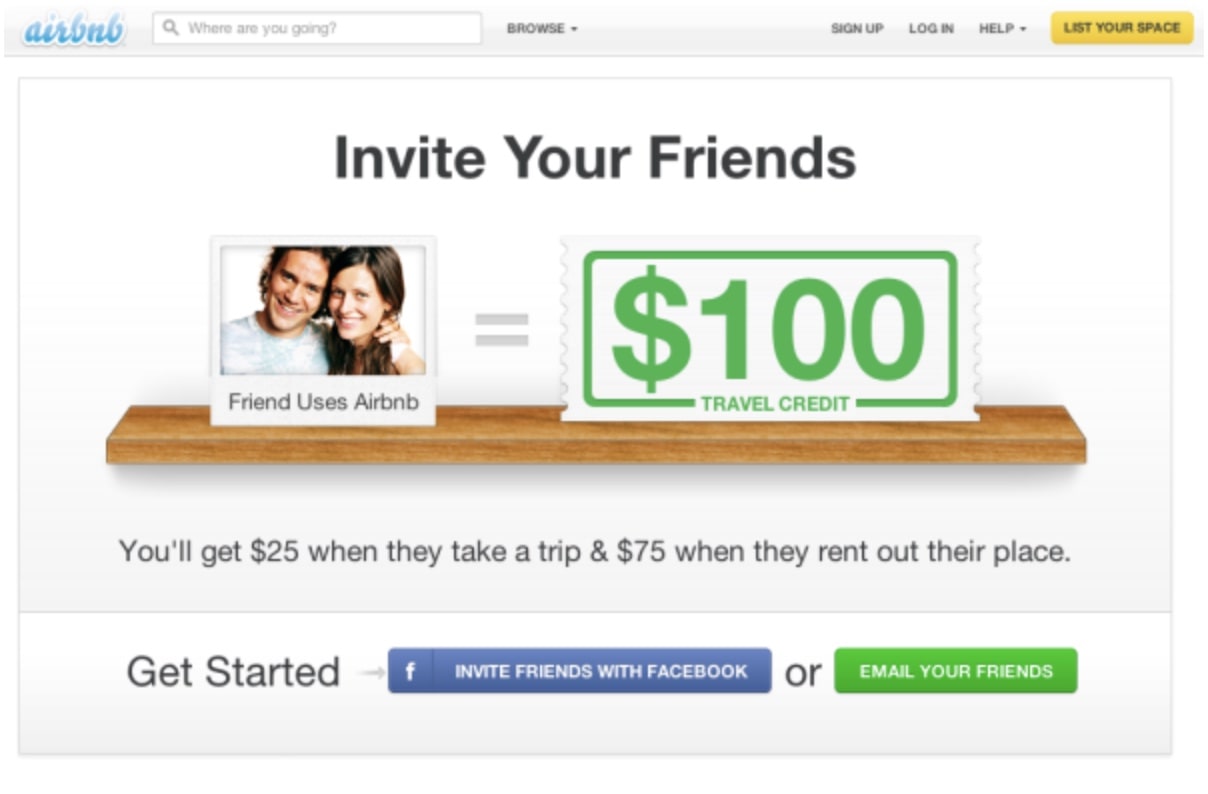The Airbnb story has become a well-documented piece of startup lore over the years.
Many people already know about how the vacation-rental unicorn began in the San Francisco apartment of Brian Chesky and Joe Gebbia, who lodged local conference-goers by offering airbed accommodation in an attempt to make rent.
It’s an inspirational story, to be sure, but it usually misses a key detail that helped lead Airbnb to a $35 billion valuation at the end of 2019.
Much of the company’s success is directly linked to their well-executed referral program. Why is Airbnb’s marketing strategy so good at bringing in new users via word of mouth? They apply the reciprocity principle.
This marketing concept refers to offering customers a reward (or some type of value) in hopes that they will complete an action in return. It helped Airbnb bolster their referral program with 300% more bookings and sign-ups.
But the journey wasn’t always smooth sailing. Chesky and Gebbia had to find Airbnb’s place in the market and test different referral program models before finding lasting success.
Airbnb Faces an Uphill Battle for Category Creation
Chesky and Gebbia knew they had something special on their hands when they first launched Airbnb in 2008 (known as airbedandbreakfast.com at the time). They saw an opportunity to create a brand new category within the vacation rental space.
To raise money for the new website, Chesky and Gebbia thought outside – or rather inside – the box. The pair came up with an innovative fundraising campaign around convention time in 2008, when presidential hopefuls Barack Obama and John McCain were running.
They launched two cereals that represented each candidate (Obama O’s and Cap’n McCain’s), which ended up raising $30,000 for the site. Alas, Chesky and Gebbia still struggled to make the website profitable and continued to track down willing investors.
That same year, a mutual friend introduced Chesky and Gebbia to seven prominent Silicon Valley investors. The pair received some positive feedback, but five of the investors declined the investment opportunity, while two others didn’t reply at all.
“The investors that rejected us were smart people, and I am sure we didn’t look very impressive at the time,” said Chesky. Interestingly enough, based on their $1.5 million valuation at the time, an investor could have had a 10% share of Airbnb for only $150,000.
Among the negative feedback they received, one investor noted that the potential marketing opportunity did not seem large enough. Airbnb’s growth team got to work on solving that problem.
Gustaf Alstromer, Airbnb’s growth product manager at the time, envisioned building a referral program as a potential solution. He saw referrals as a way to get new users to try out Airbnb and get more customers on board.

Referral Marketing – The Best Practices You Need to Know
Written by veteran referral marketers, this guide will help you optimize your referral marketing program and supercharge growth.
Get the GuideReferral Marketing Shows Early Promise
Airbnb’s first referral program (Referrals 1.0) launched in 2011. According to Alstromer, it wasn’t something that the company was particularly proud of, but it did offer important lessons.
Their goal was to get users to invite their friends and family to use the platform by offering a reward for the referral. Below is an early example of an ad Airbnb used to encourage referrals.

Source: CloudSponge
Airbnb’s push toward referrals was backed by research too. According to Nielsen, 83% of consumers say they trust product recommendations from friends and family. Ideally, the personal suggestion made consumers feel safer about trying Airbnb.
Unfortunately, a lack of promotion put a big dent in Referrals 1.0. The program had a website-only presence and minimal marketing efforts surrounding it. Referrals 1.0 still managed to bring in millions of dollars in revenue, but those figures were only scratching the surface of what would come next.
A Revamped Referral Program Breeds Success
Recognizing the potential of their referral program, Airbnb went back to the drawing board. They studied brands with successful referral programs and found that 25% to 55% of new user growth could come from referral growth channels.
One big problem was clear: Referrals 1.0 had only a single growth channel – their website. Taking what they learned from other brands, Airbnb knew they were going to need more channels than their website if they wanted to secure new user growth moving forward.
Airbnb got to work and launched Referrals 2.0 in 2014. The new and improved referral program had a redesigned web presence, and it was also accessible via the company’s iOS and Android apps.
The expansion to mobile was critical. Half of Airbnb’s emails at the time were accessed on mobile – a sign that users increasingly preferred interacting with the company on their devices. The company also learned that suggesting referrals from users’ recommended contact lists from Gmail and Android APIs boosted conversions.
Perhaps the most significant improvement to Airbnb’s referral program was the updates to their ad copy. Embracing the reciprocity principle, the language made referral invites that felt more like gifts to friends than money grabs.
To see how powerful the reciprocity principle is, consider an A/B test Airbnb ran with the two ads below.

Source: Medium
The version on the right, with altruistic copy about giving friends money, took the cake. Airbnb received a surge of international referral invitations from users after sending this message. That human-centric approach to ad copy would become a hallmark of their referral marketing efforts, and it remains true today.
The work Airbnb’s team put into Referrals 2.0 paid off in a major way. The company saw a 264% increase in referrals sent, a 489% increase in referrals that became guests, and a 497% increase in referrals that became users.
Airbnb Leans on its Strong Network of Users
Airbnb is currently in the midst of a new challenge: COVID-19. Vacation rentals are plummeting due to the global pandemic, leaving Airbnb in a tough spot.
The company has managed to stay afloat, thanks in large part to their strong, supportive network of users. A key way Airbnb gained consumers’ trust over the years was through their referral marketing. They encouraged invitations through altruistic messaging, not self-interested offers.
Referrals 2.0 proved that Airbnb knew how the reciprocity principle could impact users and nonusers. Not only did it make nonusers feel more comfortable about using the service, but it also gave active users the incentive to round up their friends and family. The benefits worked both ways, and both sides left the table with something of value – which was the point.
Sticking to altruistic messaging has helped Airbnb navigate the current crisis facing the travel industry, and that human-centric approach is something every brand can learn from to keep them strong.




